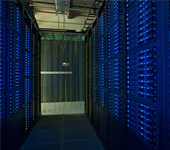Computing

The World Wide Web
CERN scientist Tim Berners-Lee developed the World Wide Web to give particle physicists a tool to communicate quickly and effectively with globally dispersed colleagues at universities and laboratories. The Stanford Linear Accelerator Center had the first website in the United States. Fermilab had the second. Few other technological advances in history have more profoundly affected the global economy and societal interactions than the Web.

The Grid
Particle physics experiments generate unprecedented amounts of data that require new and advanced computing technology to analyze. To quickly process this data, particle physicists pioneered the construction of low-cost computing farms, a group of servers housed in one location, more than two decades ago. Today, the Data Grid is the newest particle physics computing tool and allows physicists to manage and process their enormous amounts of data across the globe by combining the strength of hundreds of thousands of individual computing farms. Industries such as medicine and finance are examples of other fields that also generate large amounts of data and benefit from advanced computing technology.
- Last modified
- 05/01/2014
- email Fermilab








